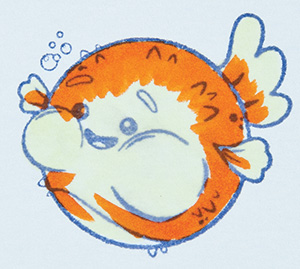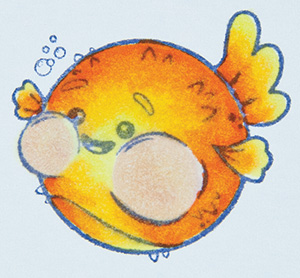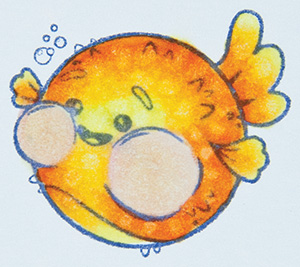
Learn How to Use Copic Markers on Colored Paper
By Colleen Schaan
One of the most popular features of Copic markers is the vibrancy of their colors. From the glowing red-violets to the dazzling blue-greens, Copic colors are intense when applied to smooth white cardstock. But what happens when they are used on colored surfaces?
Because Copic marker ink is translucent, the surface color to which it is applied remains visible. Most artists enjoy using white cardstock when coloring with their Copic markers because of the vibrant "true color" that is achieved.
Here's a small color chart done on smooth white cardstock. Notice how "pure" each color looks.
When the colors are blended together on white paper, they give very predictable results. The blues stay blue and the greens remain green.
The fun begins when you start experimenting with different surface colors. Again, because Copic ink is translucent, the surface color will have an effect on the overall ink color.
The first thing you need to do is choose a good colored paper or cardstock. Most colored papers and cardstocks are a bit softer than smooth white cardstock, so you may need to adjust your coloring style accordingly.
Each brand-and even colors within a brand-will react differently, so it's important to test your papers just as you would white cardstock.
On your chosen paper, stamp or draw a circle about the size of a quarter. Using a medium-color marker, color up to but not onto the line. Add enough ink to fully saturate the shape. Let it sit for 30 seconds. If the ink seeps outside the stamped shape, the paper may be too soft.
Once you've chosen a few different shades of paper, it's a good idea to create a sample color chart for each one. This allows you to observe which colors work well so that you can predict the results.
Below are sample color charts on different colors of paper-cream, yellow, pink, blue and kraft. Notice how different each ink color appears depending on the paper color. Also note how the lighter ink shades aremore affected by the paper color.
Now, look at the fish images above, which were colored using the exact same colors on each (B00, B000, B02, B04, G03, G24, G40, R35). Notice how the colors aren't so vibrant on the cream cardstock; how the blues and the greens appear almost the same on the yellow paper; and how the greens look almost muddy on the pink paper.
Here are some tips and tricks to keep in mind when combining colors.
Step 1: Using the lightest color (Y11), base the entire area (Photo 1).

Step 2: Add flicks of darkest color (YR07) (Photo 2).

Step 3: Add medium color (Y35). Apply ink over darkest colored area and blend edges (Photo 3).

Step 4: Add light color (Y04). Apply ink over darker areas and blend edges (Photo 4).

Step 5: Add cheeks (R81) and blend with a light color (Y11) (Photo 5).

Step 6: Add texture with Colorless Blender (Photo 6).

Even if you love the vibrancy of Copic markers on white paper, get your color on and give colored cardstock a try!
Here are some tips and tricks to keep in mind when combining colors:
- Think of "mixing" colors. For example, yellow ink on blue paper will appear slightly green; yellow ink on pink paper will appear slightly orange.
- Complementary colors can look muddy, especially lighter shades. For example, pink ink on green paper or blue ink on orange paper may tend to look dirty.
- Consider the paper's vibrancy. Vibrant papers will keep colors bright, while less saturated papers will tone down ink colors. For example, kraft paper will desaturate the ink colors.
- Be patient. Ink will appear darker when first applied. Let it dry a bit to see the truer color.
- Highlights tend to disappear quickly. Add bright highlights back in with Opaque White.
- Colorless Blender may not fix mistakes on all colored papers.
- Texture effects with the Colorless Blender tend to be soft and subtle.
Sources: Cute Fish stamp from Inkadinkado; X-Press It Blending Card white cardstock from X-Press It; Butter Mints, Sour Lemon, Cotton Candy and Icy Mint cardstocks from Bazzill Basics; Nautical Blue Memento ink from Imagine Crafts/Tsukineko.
This Copic tutorial was first published in the Summer 2013 issue of CardMaker magazine. To get more information on Copic marker techniques:
- Purchase a copy of Colleen's book Copic Coloring Guide.
- Check out Colleen's blog, www.distinctivetouches.com.
- Subscribe to CardMaker magazine, where Colleen has a regular column featuring Copic marker techniques.


